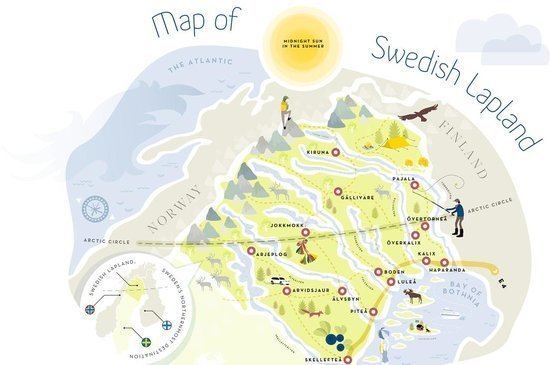Time zone CET (UTC+1) Population 94,350 (2009) | Area 109,702 km² | |
 | ||
Counties Västerbotten CountyNorrbotten CountyJämtland County | ||
Lappland, often Anglicized as Lapland (Swedish: Lappland, Latin: Lapponia, Northern Sami: Sápmi), is a province in northernmost Sweden. It borders Jämtland, Ångermanland, Västerbotten, Norrbotten, Norway and Finland. About a quarter of Sweden's surface area is in Lappland.
Contents
- Administration
- Population
- Heraldry
- Geography
- National parks
- Climate
- History
- Culture
- Sports
- Marketing
- References

Lappland originally extended eastward. However, in 1809 the Russian Empire annexed the eastern part of the Swedish realm, and created the Grand Duchy of Finland, which in effect split Lappland into a Swedish part and a Finnish part, both of which still exist today.

Administration
The traditional provinces of Sweden serve no administrative or political purposes but are cultural and historical entities. Administratively, Lappland constitutes the western part of two counties of Sweden, Norrbotten County in the north and Västerbotten County in the south. In contrast to most other areas of Sweden, there is more of an identification with the counties rather than to provinces. Thus, most people in these counties refer to the entire county, including the areas in Lappland, when they say 'Norrbotten' or 'Västerbotten'.

Citizens of Sami descent are eligible to stand and vote in elections for the Swedish Sami Parliament, which is the case with Sami people elsewhere in Sweden as well. Sami language has an official minority status in Kiruna Municipality, Gällivare Municipality, Jokkmokk Municipality and Arjeplog Municipality.
Population

As of January 1, 2016, the population of Swedish Lappland is 96,3045. Together with the rest of historical Lapland, the sum of the population is approximately 125,000. The largest city is Kiruna (Northern Sami: Giron, Finnish: Kiiruna) with 23,178 inhabitants.
Heraldry
Lappland itself was never considered a duchy but on January 18, 1884 the Privy Council gave all Provinces the right of use to a ducal coronet for their arms. Blazon Swedish version: "Argent, a Wildman statant Gules wrapped with birch leaves Vert on the head and around the waist holding a Club Or in dexter over the shoulder." The wildman used to be depicted with more features, impressively drawn muscles and a dour expression on his face..
The wildman wielding a club as heraldic symbol of Lappland first appeared at the coronation of Charles IX of Sweden in 1607, then at the same king's burial in 1611. The colour red of his skin was decided only in 1949; before then various colours had been used (natural skin colour in the first half of the 20th century). The wildman, though unusual in heraldry, is an old symbol of the uncivilized north and appeared in books and woodcuts of the 16th century.
Geography
Located in Sweden. Lapland is known for containing the Vindelfjällen Nature Reserve, one of the largest nature reserves in Sweden. Other parts of Lappland have been named a UNESCO World heritage site, the Laponian area, and the province contains some of the oldest and most spectacular national parks of northern Europe, e.g. Sarek National Park, established in 1909. Lappland has an area of 109,702 square km (c. 42,300 sq miles), almost equal to Portugal.
National parks
Climate
Lappland has a subarctic climate in its lower areas, whereas a polar variety can be found in Tarfala, where the average high for the warmest month of the year (July) is lower than 10 °C (50 °F) in mean temperatures. The southern parts of the province is significantly milder than the northern, due to the vast geographical differences. However, since Lappland is all made up of inland areas, maritime moderation is less significant than in the counties' coastal areas and in neighbouring Norway, resulting in harsh winters. Southern areas at a lower elevation such as Lycksele also have relatively warm summers. Due to the arctic circle, the northern areas of the province experience midnight sun and a moderate polar night with some civil twilight during opposite sides of the year.
History
The history of Lappland is in many ways connected to the history of Norrbotten County and Västerbotten County, since Lappland is a historic region connected to these counties. During the Middle Ages, Norrbotten/Lappland was considered a no man's land. The area was in fact populated by nomadic Sami people, but the region became increasingly settled by Swedish, Finnish and Norwegian settlers - especially along the coasts and large rivers. From the Middle Ages on, the Swedish kings tried to colonise and Christianise the area using settlers from what is now Finland and southern Sweden. Today, despite large-scale assimilation into the dominant Swedish culture, Finnish and Sami minorities continue to maintain their cultures and identities.
In religion, nonetheless, in the 17th and 18th centuries the Lapplanders generally left their original shamanism and converted to Lutheranism. Since the 19th century, Lappland has been particularly characterised by Laestadian Lutheranism.
During the industrialisation of Sweden, natural resources (hydroelectricity, timber and minerals) from Lappland and surrounding provinces played a key role. Still, mining, forestry and hydroelectric power are the backbone of the local economy, together with municipal services. The unemployment has however been relatively high for several decades and many young people leave for the larger cities by the coast or in southern Sweden.
Culture
The culture of the Sami people, and the conservative Lutheran Laestadian movement is prominent in the region.
Sports
Football in the province is administered by Norrbottens Fotbollförbund and Västerbottens Fotbollförbund.
Marketing
An EU-subsidized tourism marketing homepage aiming to promote tourism in Northern Sweden has taken the brand name "Swedish Lapland". Tourist should be aware that its marketing also covers towns in the coastal area of Gulf of Bothnia as well as the boarder area to Finland though neither areas are a part of the geographical province Swedish Lapland.
